Podcast
Questions and Answers
What is the literal meaning of the word 'wika'?
What is the literal meaning of the word 'wika'?
tongue and language
According to Henry Gleason, what is the definition of language?
According to Henry Gleason, what is the definition of language?
a systematic framework of spoken sounds arranged arbitrarily for communication
Which of the following is NOT a characteristic of language?
Which of the following is NOT a characteristic of language?
- Language is arbitrary
- Language is based on culture
- Language is static (correct)
- Language is dynamic
What is one of the functions of language as described by Dell Hymes?
What is one of the functions of language as described by Dell Hymes?
Which theory suggests that language originated from imitating animal sounds?
Which theory suggests that language originated from imitating animal sounds?
Match the following levels of language with their descriptions:
Match the following levels of language with their descriptions:
The term 'Pidgin' refers to a 'nobody’s native language' with no structure.
The term 'Pidgin' refers to a 'nobody’s native language' with no structure.
What does 'Sosyolek' refer to in the context of language variation?
What does 'Sosyolek' refer to in the context of language variation?
Flashcards are hidden until you start studying
Study Notes
Definition of Language
- The word "wika" originated from the Spanish word "lengua" which literally means tongue and language.
- Henry Gleason stated that language is a systematic framework of spoken sounds chosen and arranged arbitrarily for use in communication by people in the same culture.
- Edward Sapir defined language as a natural and human way of conveying thoughts, feelings, and aspirations.
- Carrol defined language as a system of symbols created and accepted by society.
Characteristics of Language
- Language has a systematic framework
- Language is made up of sounds
- Language is chosen and arranged
- Language is arbitrary
- Language is constantly used
- Language is based on culture
- Language is dynamic
- Language is used in communication
- Language has different levels
Importance of Language
- Instrument of Communication
- Preserves and disseminates knowledge
- Enriches culture
- Symbolizes sovereignty
- Serves as a lingua franca
Theories of Language Origin
- San Juan 1.1: “In the beginning was the Word, and the Word was with God, and the Word was God”
- Tower of Babel: according to the Bible story, there was only one language in the beginning, resulting in easy communication. Humans sought to exceed God's power, became arrogant, and aspired to reach heaven, constructing a towering tower.
- Bow-Wow Theory: imitation of animal sounds.
- Ta-Ta Theory: hand gestures.
- Ding-Dong Theory: sounds from the surrounding environment.
- Yo-he-ho Theory: physical force.
- Pooh-Pooh Theory: intense emotions.
- Tararaboom-de-ay Theory: rituals.
Language and Related Information
- Dell Hymes defines communicative competence as the ability to use language appropriately in situations, considering factors such as who one is communicating with, the reason for communication, where it occurs, the flow of conversation, and the topic. (SPEAKING)
- Peter Trudgill argued that language goes beyond communication and information exchange; it's crucial for maintaining relationships between people. It aims to influence the actions, thoughts, and feelings of the user and the receiver.
- M.A.K Halliday, in his work "Explorations in the Functions of Language," categorized language functions based on its roles in our lives:
- Heuristic – achieving or seeking (survey, research).
- Imaginative/Imaginative – imagination.
- Instrumental – addressing needs.
- Interactional – interacting with others or building relationships.
- Personal – expressing personal opinions.
- Regulatory – control.
- Informative/Representative – providing knowledge or information.
Levels of Language
- Formal: standardized words recognized, accepted, and used by a majority, especially educated speakers.
- National: used by everyone and understood throughout the country. It's also used as a medium of instruction and government communication.
- Semantic/Rhetorical: highest level of language, rich in idioms, figures of speech, and figurative expressions (uses deep words).
- Technical: words used in science and mathematics.
- Informal: frequently used in everyday conversations
- Provincial: used in a specific place or region.
- Colloquial: shortened words.
- Slang: the lowest level, using everyday language (similar to slang in English)
Language Varieties
- Fantini (2000): language varieties are influenced by important social factors like location, topic, type of communication, use of interactions, and participants.
- Dialect: specific group from a particular area (Example: Kapampangan spoken in Sasmuan).
- Idiolect: personal language (Example: "Excuse me po!" by Mike Enriquez).
- Sociolect: jejemon, conyo, gay language.
- Ethnolect: ethnolinguistic group.
- Ecolect: words used inside the home (Example: "KUBETA").
- Pidgin: "nobody's native language," lacking structure (Example: "ikaw utang").
- Creole: a language that originated from a pidgin and later became the primary local language (Example: CHAVACANO).
- Jargon: terminology used by a specific group or profession.
- National Language: Tagalog based language, used by everyone and understood throughout the country. It’s also used as a medium of instruction and government communication.
Studying That Suits You
Use AI to generate personalized quizzes and flashcards to suit your learning preferences.




